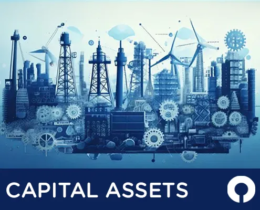Asset Management vs. Asset Tracking: What’s the difference?
Here are the key differences between asset management and asset tracking, two essential processes that can boost efficiency and revenue in your organisation
Here are the key differences between asset management and asset tracking, two essential processes that can boost efficiency and revenue in your organisation
Asset tracking is an important aspect of asset management, and both are essential for organisations to operate efficiently and successfully. The terms are often used interchangeably, and their scope does overlap, but they are different and should be understood separately. So what are the differences between asset tracking and asset management, and what exactly does each involve? Read on to learn everything you need to know about these two processes.
An asset is any item owned or right possessed by an individual or company which has value, whether it be economic, commercial, or exchangeable value. A company’s assets may include machinery, tools, equipment, vehicles, land, people, money, furniture, and more.
The International Financial Reporting Standards (IFRS) defines an asset as ‘a present economic resource controlled by the entity as a result of past events. An economic resource is a right that has the potential to produce economic benefits.’
There are two main categories of asset: intangible assets and tangible assets. The former are non-physical resources such as bonds, stock, copyrights, patents, trademarks, and computer software. However, these are less relevant to our discussion of asset management and tracking. Here, we’re mainly looking at tangible assets, which are physical resources. These are grouped into two main sub-categories: current assets (inventory, cash, accounts receivable), and fixed assets (equipment, machinery, buildings, and land).
Fixed assets are the type of assets that are most relevant to our discussion of asset management and tracking. These are physical assets that are used by an organisation in its operations to produce income and are unlikely to be converted into cash. Specifically, an asset considered a fixed asset is not expected to be sold within one year. Because of the long lifespan of fixed assets, organisations need to depreciate the value of these physical assets over time.
Asset tracking is an important part of the wider asset management strategy. Asset tracking deals with tracking the location, status and other asset data for different physical assets such as machinery and equipment. This tracking can be done using barcodes, QR codes, or RFID tags, which make it easy to track the movements and location of assets in real-time. Each asset has its unique asset ID which is used for tracking and updating the asset register.
Why is asset tracking important? A good system for asset tracking makes it easy to view up-to-date information about all fixed assets, including data about the asset’s location, who used it last, who it is assigned to, the condition it is in, when it was last repaired, and when it will need to be replaced. This allows organisations to gain visibility and control over the asset register, no matter whether they’re a small business with just a few assets or a multinational corporation with thousands of assets across multiple sites and books.
An effective asset tracking system streamlines your audits, increasing accuracy and reducing the amount of time that audits take to complete. Easy auditing with the scan of a barcode makes compliance easier than ever.
With a good asset tracking system, it’s easier to keep tabs on the location and status of assets at any time and in any location. This means that you don’t need to waste time or unnecessary administrative costs locating missing assets or replacing them.
Effective asset tracking reduces the risk of losing assets through mistakes or theft, increasing your visibility and ensuring asset security.
With an accurate asset register at all times, organisations can work more efficiently, improving the quality of their products, customer service, and more.
Asset management is a broader concept than asset tracking. In addition to tracking asset details, it also deals with monitoring the status of assets, maintaining them to keep them in good working condition, reducing asset downtime, managing inventory, and keeping everything working as efficiently and cost-effectively as possible. It traces the asset’s entire lifecycle, from the moment of its purchase to its eventual disposal.
Comprehensive asset management software might also take this a step further by calculating and forecasting depreciation for assets. This allows you to automatically depreciate assets in your books for better reporting and more accurate future planning.
Effective asset management means staying on top of maintenance with scheduled and preventative maintenance tasks reducing the downtime of machinery and equipment. This means that assets can be kept operational for longer, minimising replacement costs.
An effective asset management system helps you ensure that all relevant accounting standards and regulations are being complied with. This includes IFRS, local GAAP, SORP, and more.
You can audit more quickly, effectively, and accurately with good asset management software. An effective system allows you to reduce the risk of misplaced or stolen items.
With a good asset management strategy, organisations can eliminate wasted time spent searching for assets or wasted money on duplicate or unnecessary purchases. This can result in increased quality, customer service, and revenue over time.
In short, asset management refers to the management and maintenance of assets across the entire asset lifecycle. Asset tracking, the process of tracking the location and status of assets in real-time, is just one aspect of this.
Both asset tracking and management are essential for asset-rich organisations looking to boost efficiency and revenue while streamlining audits and maintenance. To automate aspects of these processes, many organisations will use asset management or asset tracking software or a CMMS (Computerised Maintenance Management System).
Asset tracking and management software can streamline or automate processes such as audits, depreciation calculations, audits, and reporting. Integrating these two functions into a single software solution allows companies to improve their efficiency and have a beneficial impact on their bottom line.
In the market for first class asset tracking and asset management software? FMIS is the solution. Available both on-premises or in the cloud, FMIS uses integrated modules such as fixed asset management, asset tracking, purchase to pay, and equipment maintenance to provide an all-in-one solution. Designed for medium to large enterprises, our asset management software is used by clients in a range of fields including manufacturing, energy, and health, in the United Kingdom and more than 40 other countries around the world. We even offer a mobile app asset tracker and management solution to make our software even more accessible and easy to use.
To learn more about how asset management and asset tracking software benefits our clients, read the case study of how FMIS has been used by engineering firm SPS Aero. Or, read about how our client Essex Fire Authority has used FMIS asset management software to save time and money.
FMIS asset management software is a smart investment for any organisation looking to streamline its asset needs. To learn more about how FMIS can benefit your business, download our brochure or get in touch today.
 /wp-content/uploads/2024/12/Depreciation-Review-495x400-1.webp400495John de Robeck/wp-content/uploads/2016/07/FMIS-logo-340x156.pngJohn de Robeck2024-12-18 15:04:412025-02-13 16:03:51What is a Depreciation Review and when is it needed?
/wp-content/uploads/2024/12/Depreciation-Review-495x400-1.webp400495John de Robeck/wp-content/uploads/2016/07/FMIS-logo-340x156.pngJohn de Robeck2024-12-18 15:04:412025-02-13 16:03:51What is a Depreciation Review and when is it needed? /wp-content/uploads/2024/12/Capital-Asset-Management-495x400-1.webp400495John de Robeck/wp-content/uploads/2016/07/FMIS-logo-340x156.pngJohn de Robeck2024-12-09 10:09:252025-02-13 16:03:50What is Capital Asset Management Software? (CAM)
/wp-content/uploads/2024/12/Capital-Asset-Management-495x400-1.webp400495John de Robeck/wp-content/uploads/2016/07/FMIS-logo-340x156.pngJohn de Robeck2024-12-09 10:09:252025-02-13 16:03:50What is Capital Asset Management Software? (CAM) /wp-content/uploads/2024/12/G-Cloud-14-approved-supplier-495x400-1.webp400495John de Robeck/wp-content/uploads/2016/07/FMIS-logo-340x156.pngJohn de Robeck2024-12-05 16:00:312025-02-13 16:03:49G-Cloud 14 Approved Supplier
/wp-content/uploads/2024/12/G-Cloud-14-approved-supplier-495x400-1.webp400495John de Robeck/wp-content/uploads/2016/07/FMIS-logo-340x156.pngJohn de Robeck2024-12-05 16:00:312025-02-13 16:03:49G-Cloud 14 Approved Supplier /wp-content/uploads/2024/10/Optimising-Fixed-Asset-Lifecycles-495x400-1.webp400495John de Robeck/wp-content/uploads/2016/07/FMIS-logo-340x156.pngJohn de Robeck2024-10-25 13:08:502025-02-13 16:03:48Optimising Fixed Asset Lifecycles: From Acquisition to Disposal
/wp-content/uploads/2024/10/Optimising-Fixed-Asset-Lifecycles-495x400-1.webp400495John de Robeck/wp-content/uploads/2016/07/FMIS-logo-340x156.pngJohn de Robeck2024-10-25 13:08:502025-02-13 16:03:48Optimising Fixed Asset Lifecycles: From Acquisition to DisposalFMIS Ltd
167b John Wilson Business Park
Whitstable
Kent
CT5 3RA
United Kingdom
Phone:+44 (0) 1227 773003
Fax:+44 (0) 1227 773005
Sales:sales@fmis.co.uk
Support:support@fmis.co.uk

| Cookie | Duration | Description |
|---|---|---|
| cookielawinfo-checkbox-advertisement | 1 year | Set by the GDPR Cookie Consent plugin, this cookie is used to record the user consent for the cookies in the "Advertisement" category . |
| cookielawinfo-checkbox-analytics | 11 months | This cookie is set by GDPR Cookie Consent plugin. The cookie is used to store the user consent for the cookies in the category "Analytics". |
| cookielawinfo-checkbox-functional | 11 months | The cookie is set by GDPR cookie consent to record the user consent for the cookies in the category "Functional". |
| cookielawinfo-checkbox-necessary | 11 months | This cookie is set by GDPR Cookie Consent plugin. The cookies is used to store the user consent for the cookies in the category "Necessary". |
| cookielawinfo-checkbox-others | 11 months | This cookie is set by GDPR Cookie Consent plugin. The cookie is used to store the user consent for the cookies in the category "Other. |
| cookielawinfo-checkbox-performance | 11 months | This cookie is set by GDPR Cookie Consent plugin. The cookie is used to store the user consent for the cookies in the category "Performance". |
| CookieLawInfoConsent | 1 year | Records the default button state of the corresponding category & the status of CCPA. It works only in coordination with the primary cookie. |
| PHPSESSID | session | This cookie is native to PHP applications. The cookie is used to store and identify a users' unique session ID for the purpose of managing user session on the website. The cookie is a session cookies and is deleted when all the browser windows are closed. |
| viewed_cookie_policy | 11 months | The cookie is set by the GDPR Cookie Consent plugin and is used to store whether or not user has consented to the use of cookies. It does not store any personal data. |
| Cookie | Duration | Description |
|---|---|---|
| CONSENT | 2 years | YouTube sets this cookie via embedded youtube-videos and registers anonymous statistical data. |
| _ga | 2 years | The _ga cookie, installed by Google Analytics, calculates visitor, session and campaign data and also keeps track of site usage for the site's analytics report. The cookie stores information anonymously and assigns a randomly generated number to recognize unique visitors. |
| _gat_UA-48954022-1 | 1 minute | A variation of the _gat cookie set by Google Analytics and Google Tag Manager to allow website owners to track visitor behaviour and measure site performance. The pattern element in the name contains the unique identity number of the account or website it relates to. |
| _gid | 1 day | Installed by Google Analytics, _gid cookie stores information on how visitors use a website, while also creating an analytics report of the website's performance. Some of the data that are collected include the number of visitors, their source, and the pages they visit anonymously. |
| Cookie | Duration | Description |
|---|---|---|
| VISITOR_INFO1_LIVE | 5 months 27 days | A cookie set by YouTube to measure bandwidth that determines whether the user gets the new or old player interface. |
| YSC | session | YSC cookie is set by Youtube and is used to track the views of embedded videos on Youtube pages. |
| yt-remote-connected-devices | never | YouTube sets this cookie to store the video preferences of the user using embedded YouTube video. |
| yt-remote-device-id | never | YouTube sets this cookie to store the video preferences of the user using embedded YouTube video. |
